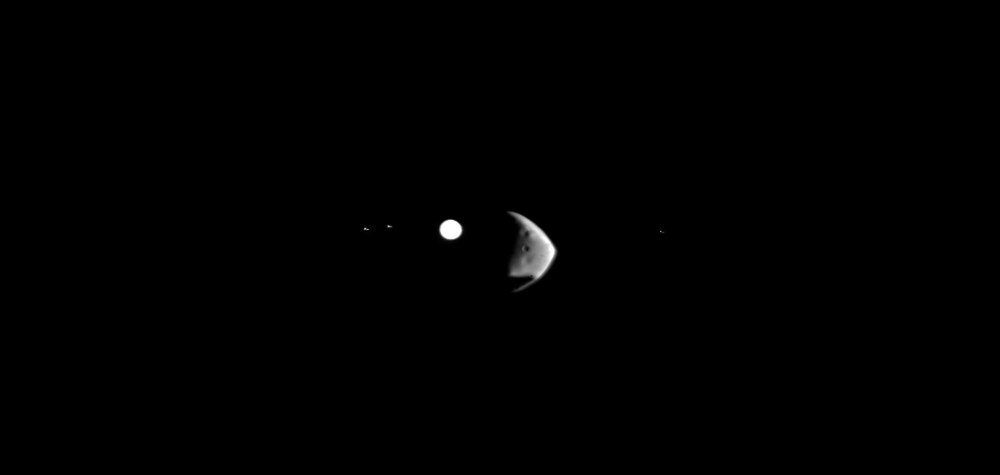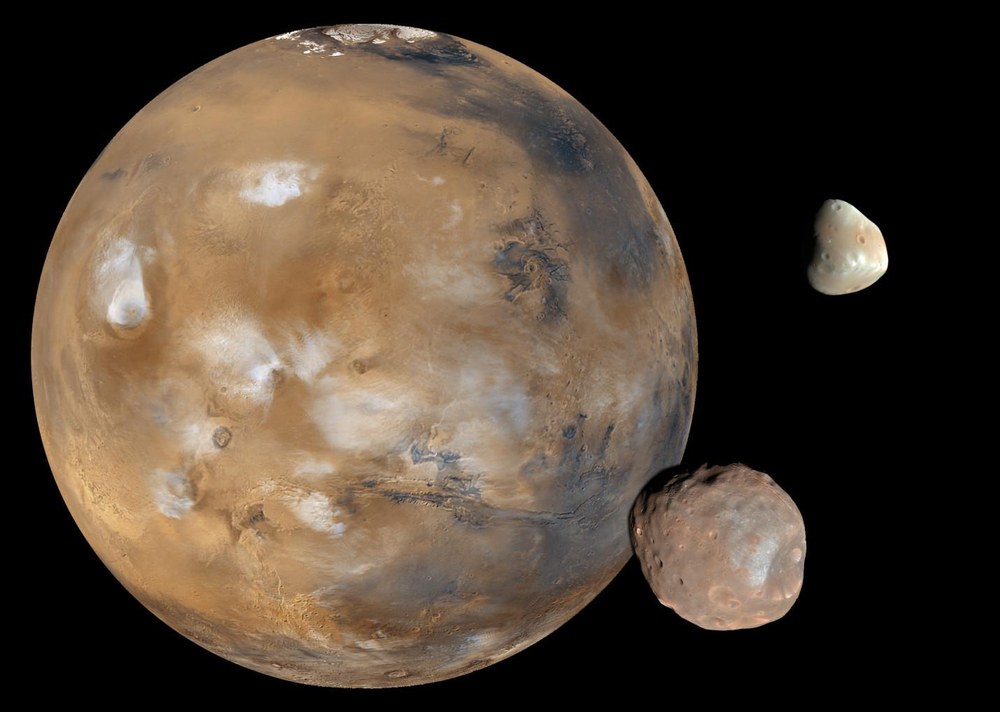Impressive rendezvous of Solar System moons observed by Europe's HRSC Mars camera
- On 14 February 2022, Deimos, the smaller of Mars' two moons, passed in front of Jupiter and its four Galilean moons.
- Then, on 30 March, the larger Martian moon Phobos eclipsed Deimos.
- Images from the European High Resolution Stereo Camera show these interesting celestial alignments.
- Focus: Space, Solar System exploration, Mars, DLR stereo camera
The German Aerospace Center (Deutsches Zentrum für Luft- und Raumfahrt; DLR) High Resolution Stereo Camera (HRSC) on board the Mars Express orbiter has been in operation since January 2004. It not only has an eye for the Red Planet, but also regularly observes the two Martian moons, Phobos and Deimos, as well as other Solar System bodies during interesting celestial alignments.
One such cosmic alignment occurred on 14 February 2022. The smaller of the two Martian moons, Deimos, passed in front of Jupiter and its four Galilean moons as seen from the Mars Express spacecraft. In this animation, you can see how Deimos first obscures Europa and Ganymede, then Jupiter, and finally Io and Callisto. It was created from 80 images acquired using the 985 mm Super Resolution Channel (SRC) telephoto lens of the HRSC.

Video: Occultation of Jupiter by Deimos
Your consent to the storage of data ('cookies') is required for the playback of this video on Quickchannel.com. You can view and change your current data storage settings at any time under privacy.
ESA/DLR/FU Berlin – CC BY-SA 3.0 IGO, K.-D. Matz
This type of observation is very rarely possible, as Deimos must be located exactly in the orbital plane of Jupiter's moons. The constellation is made a little more probable by the fact that both moons orbit Mars in the planet's equatorial plane, and thus are also occasionally in the orbital plane of Jupiter and its moons. This is likely no coincidence and is an important factor to consider when investigating the possible origin of the two Martian moons. The debate has been going on for decades: if Phobos and Deimos are 'captured' asteroids, as their dark surfaces suggest, then the fact that they both orbit in the equatorial plane would be an amazing coincidence. If, however, they are made of rock that was hurled from Mars during an impact, these orbits would be much more likely. However, the extremely dark material that makes up Phobos and Deimos disputes this theory. The Martian Moons eXploration (MMX) mission, a collaboration between Japan, France and Germany, will arrive at the Mars system in 2025 and attempt to answer this question
Increasing precision of Martian moon orbital data
Jupiter's four largest moons are only visible as small white dots in this animation. Their distance from the camera is approximately 745 million kilometres – roughly five astronomical units, or five times the distance from Earth to the Sun. Due to the far greater brightness of Deimos and Jupiter, the moons would not have been visible at all here if the images had not been separately contrast-enhanced at the positions of the moons. The vertical motion of Deimos is caused by the swinging of Mars Express' 12-metre solar cells and its 7-metre and 20-metre radar antennas as the satellite rotates towards the direction of the targets to be observed.
These images also serve an important scientific purpose – the precise determination of the orbits of the Martian moons. Due to the tidal forces exerted on the moons by Mars, their orbits are constantly changing. Phobos, currently 6000 kilometres from the surface of Mars, is spiralling towards the planet. In 30,000 to 40,000 years, it will be so close that it will reach the 'Roche limit' and be torn apart by the incredibly strong tidal forces, causing it to crumble and perhaps form a ring of debris around the Martian equator.
Deimos' orbit, on the other hand, is 20,000 kilometres above the Martian equator and expanding, so the moon will one day escape the planet. Continuous recalculation of the orbits of both moons is therefore essential. Since the position of Jupiter and its moons is known very precisely, they can be used as reference bodies in these images to determine the position of Deimos. Hundreds of images acquired using the HRSC in the years since 2004 have contributed significantly to calculating these ephemerides – the orbital trajectories of both moons and how they change – as a function of time.
Clarity at last? Martian Moons eXploration mission to launch in 2024
Another example of astrometry images that are both useful and aesthetically valuable can be seen in the second animation, in which the larger and inner Martian moon, Phobos, sweeps in front of Deimos. To produce this, 19 images acquired by the Super Resolution Channel (SRC) of the HRSC on 30 March 2022 were combined. The distance from Mars Express to Phobos here is 12,261 kilometres, and 27,907 kilometres to Deimos. The difference in size between the two irregularly shaped bodies cannot be appreciated from this perspective. Phobos has a diameter of approximately 27 kilometres along its largest axis, while Deimos is 15 kilometres wide at its largest axis.

Video: Occultation of Deimos by Phobos
Your consent to the storage of data ('cookies') is required for the playback of this video on Quickchannel.com. You can view and change your current data storage settings at any time under privacy.
ESA/DLR/FU Berlin – CC BY-SA 3.0 IGO, K.-D. Matz
Calculating the orbits of the Martian moons is very difficult from Earth. They can only be observed using larger telescopes as they are located very close to their planet and the brightness of Mars obscures them. Mars orbiters can align themselves with the Red Planet 'behind' them, from where their onboard cameras can observe the moons much more easily and achieve far more accurate results. Knowing the moons' exact position in their orbit around Mars is essential, not least for the planning of MMX, a mission with significant European participation that will place a lander and a mobile robot on Phobos in the middle of the decade.
Related links
The HRSC experiment on Mars Express
The High Resolution Stereo Camera (HRSC) was developed by the German Aerospace Center (Deutsches Zentrum für Luft- und Raumfahrt; DLR) and built in collaboration with partners in industry (EADS Astrium (now Airbus), Lewicki Microelectronic GmbH and Jena-Optronik GmbH). The science team, which is headed by Principal Investigator (PI) Thomas Roatsch, consists of 52 co-investigators from 34 institutions in 11 countries.
These high-resolution images and more images acquired by HRSC can be found in the Mars Express image gallery on flickr.

